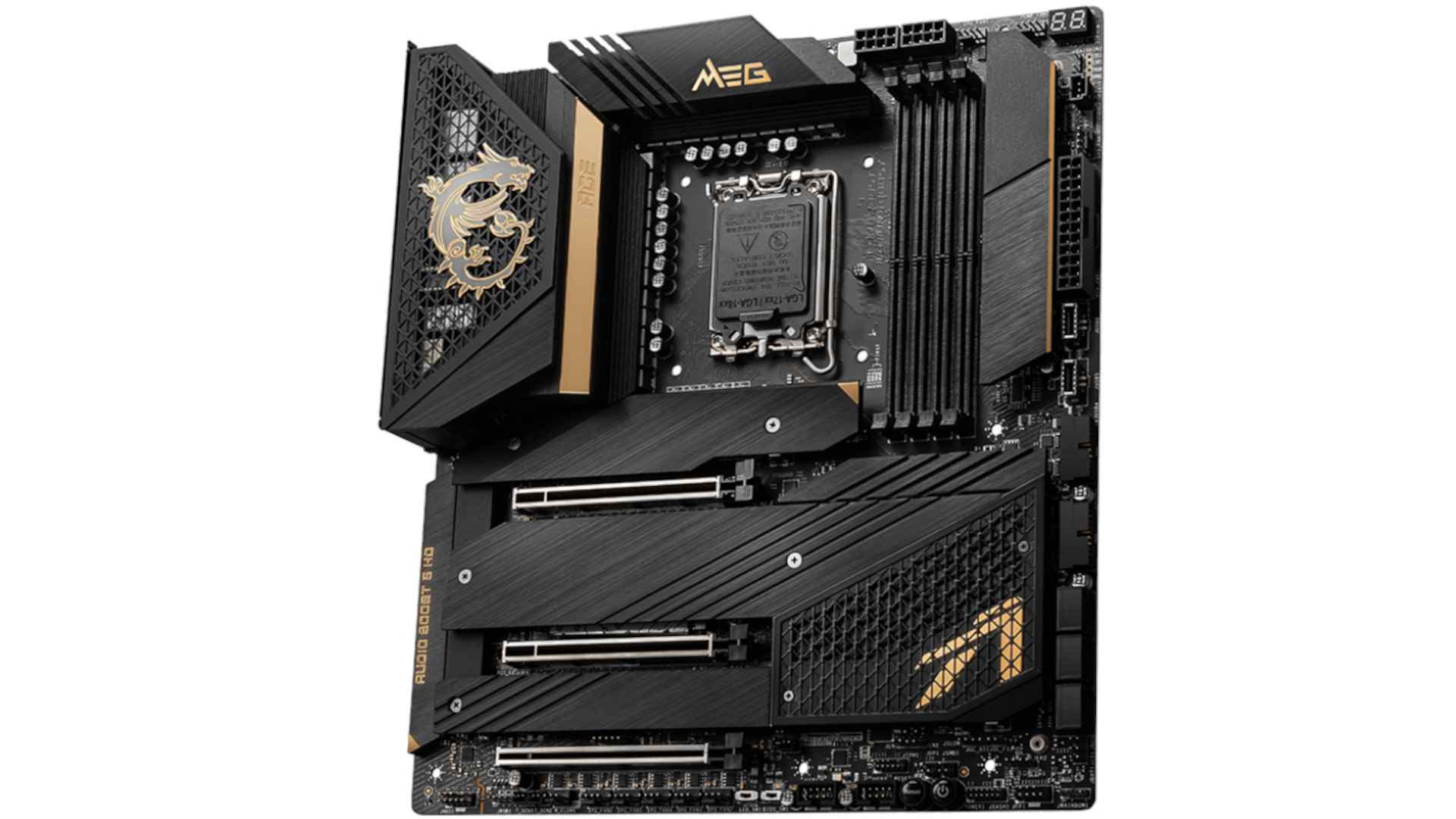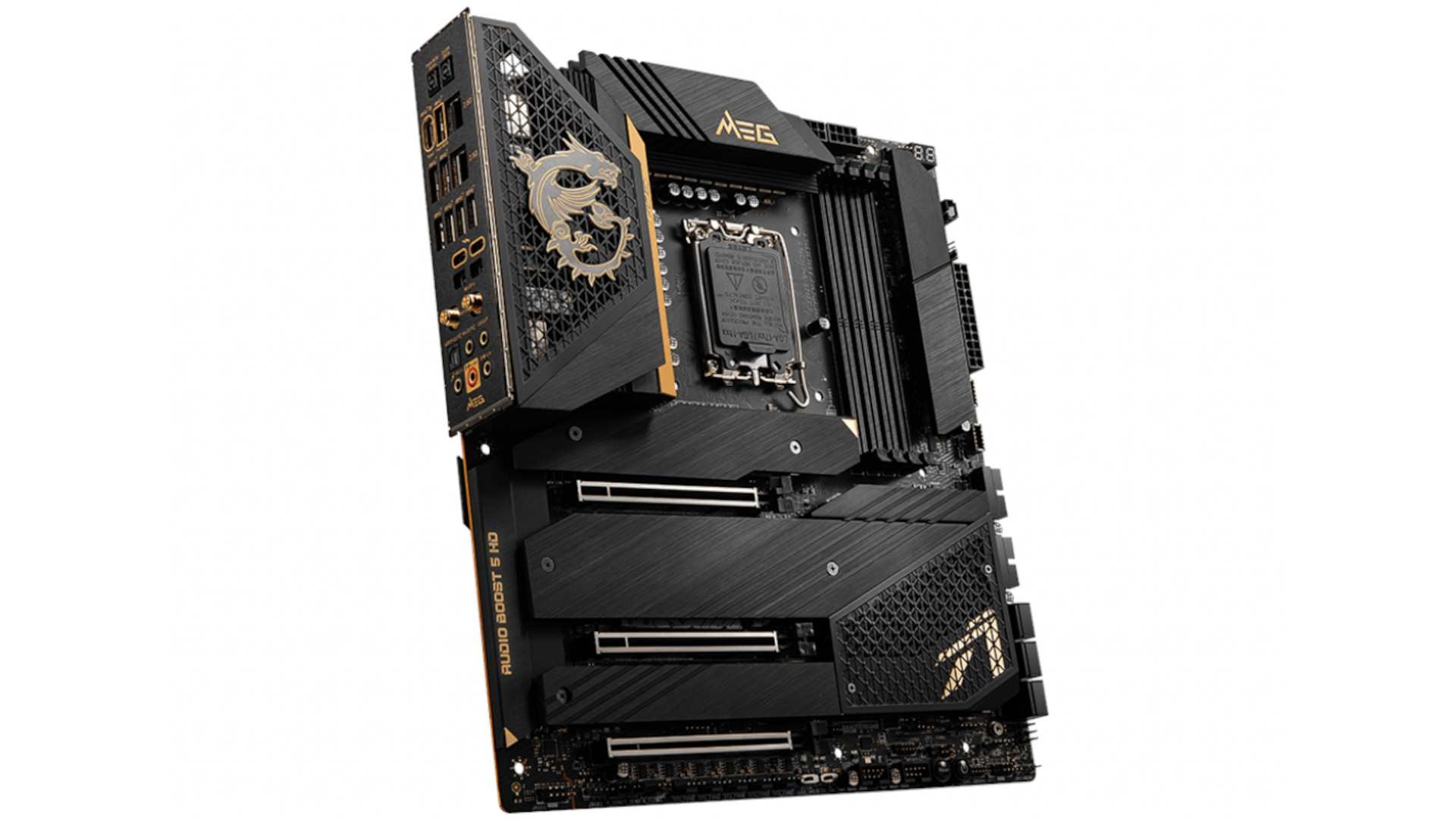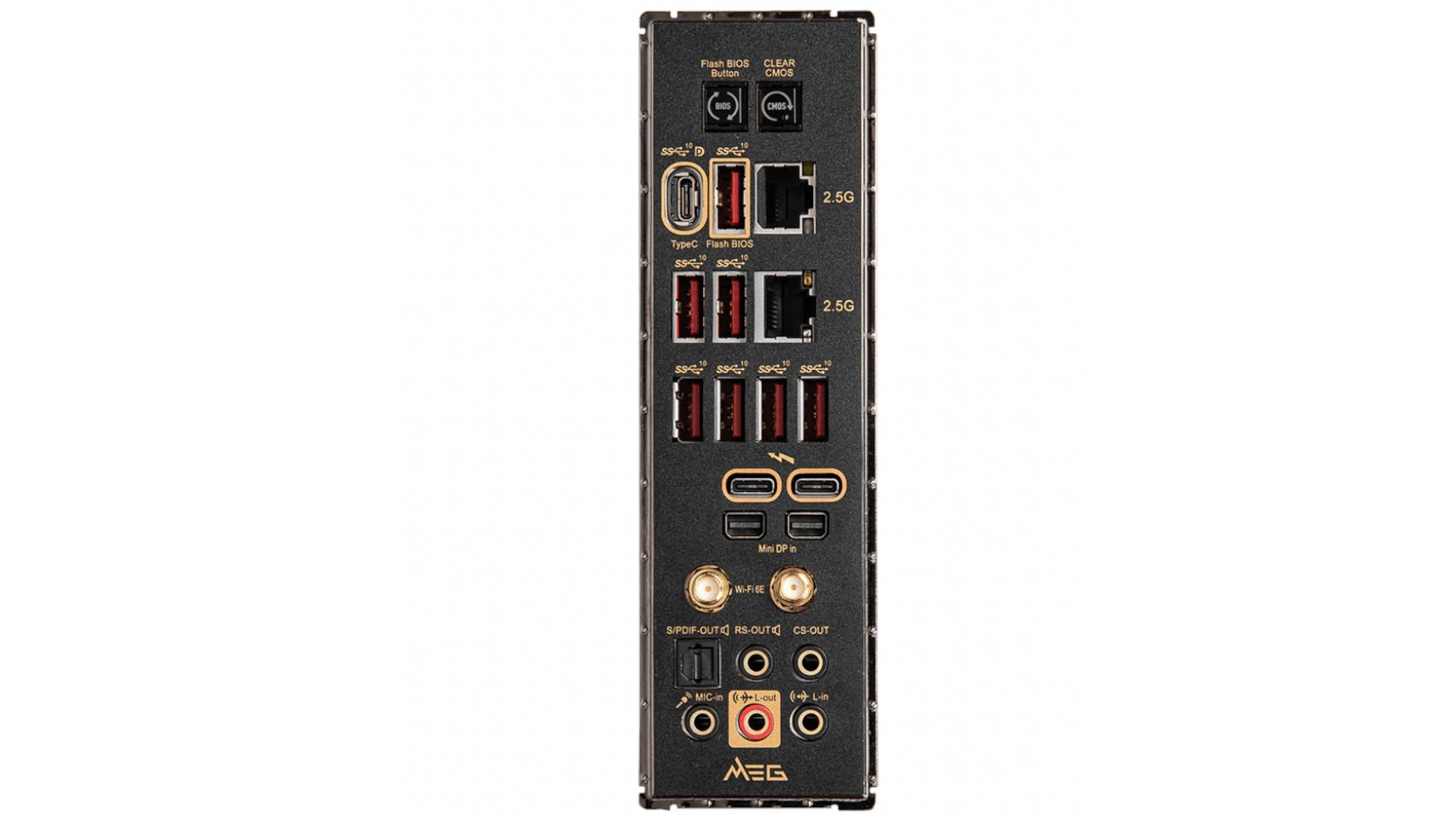The MSI MEG Z690 ACE Gaming Motherboard is likely one of the most intriguing Z690 motherboards available out of all the Z690 chipset motherboards we’ve encountered since Intel introduced its 12th Gen Core CPUs. The MEG Z690 ACE, which comes in an E-ATX form factor and includes its well-known black and gold color scheme, offers quite a few features that you would typically find on a top-tier Z690 motherboard.
In the market for PC enthusiasts, Micro-Star International (MSI) is not a new name. They were founded in Taiwan in 1986 and primarily made motherboards and graphics cards. With its own “Gaming” brand of PC parts, laptops, monitors, coolers, and peripherals, MSI has now entered the gaming business. They also have a global presence in more than 120 countries and are active in the automobile industry, industrial-grade servers, and robotic automation.
The MSI MEG Z690 ACE Gaming Motherboard is now the company’s top flagship model until the Godlike, which is expected to arrive after Alder Lake’s introduction, hits the market. Going back to the Ace, we see that it has all the high-end features we’ve come to anticipate over the years, including those from the MSI MEG Z590 Ace that came before.
Without requiring integrated RGB LED lighting, MSI chose a black and gold theme for the design. Even though the gold isn’t as prevalent among other hardware components, which could make hardware matching difficult, the board still has a really elegant appearance.
The MSI MEG Z690 Ace, which resembles a gladiator wearing gold and black armor, includes two full-length PCIe 5.0 slots that can run at either x16 or x8/x8, as well as one full-length PCIe 4.0 slot for good measure. The number of M.2 slots is increased to five with the addition of one PCIe 3.0 x4 slot, supporting a total of four PCIe 4.0 x4 M.2 drives.
Additionally, MSI has six SATA ports that are compatible with Intel RAID 0, 1, and 10 arrays. Four memory slots with a total capacity of up to 128 GB are situated in the top-right corner and support up to DDR5-6666.

MSI MEG Z690 ACE Gaming Motherboard Packaging
The retail package for the MSI MEG Z690 ACE Gaming Motherboard is really attractive. A picture of the board is on the front. The board’s various features are described in depth on the back, along with a list of specifications and an explanation of the back I/O ports.
You’ll discover quite a bit after opening the package and taking everything out but the motherboard. The WiFi antenna, screwdrivers, a USB drive, four SATA cables, three sets of RGB extension cables, two DP to mini DP cables, an EZ front panel cable, M.2 screws and standoffs, screwdrivers, a cleaning brush, two thermistor cables, cable stickers, MSI stickers, a quick installation guide, a user’s guide, and a case badge are all included in the accessories.
MSI MEG Z690 ACE Gaming Motherboard Specs & Performance
The MSI MEG Z690 ACE is compatible with LGA 1700-socketed 12th generation Intel processors. To support the 24-thread, 22-phase Intel Core i9-12900K, the board contains a 22-phase (19+1+2) VRMS, which is cooled by two sizable machined metal heat sinks joined by a heat pipe.
To ensure proper contact and heat dissipation, the MOSFETs and the chokes include 7 W/mK thermal pads. An 8-layer PCB constructed using IT-170 server-grade PCB material and 2 oz thicker copper also aids in heat dissipation.

The MEG Z690 ACE features four DIMM slots that can accommodate up to 128 GB of dual-channel, 6666 MHz, non-ECC memory. On the QVL, we can find single-rank Hynix choices from ADATA that are rated for 6666 MHz.
We have three full-length PCIe x16 slots for PCIe, however only the top slot is x16 electrically. The table below provides a bandwidth split. The two slots closest to the CPU will operate in PCIe Gen 5.0 mode (x16/x0 and x8/x8), while the two slots closest to the PCH will operate in Gen 4.04 and share bandwidth with the M.2 slot directly above it. The three full-length PCIe slots are strengthened by MSI’s PCI Express Steel Armor technology, which includes EMI shielding for signal integrity and reinforced, hefty solder spots.
The MEG Z690 ACE Gaming Motherboard has six SATA 6 Gb/s ports for storage, including two from an ASMedia ASM1061 controller and four from the PCH, which enable RAID 0, 1, and 10. MSI has five sockets on the ACE for the M.2 side.
PCIe NVMe drives are supported by all five sockets. PCIe NVMe and SATA-based M.2 drives are supported in the two lowest M.2 (Key-M). slots; however, using a SATA-based drive in the fifth M.2 slot will disable the seventh SATA 6 Gb/s connection. The M.2 drive slots all have built-in heat spreaders. For further information on the storage configuration and drive compatibility, see the table below or the user manual on the MSI website.
With 18 possible connections between onboard headers and the rear I/O shield, USB connectivity is also widely available on the MEG Z690 ACE. There are eight USB 3.2 Gen2 Type-A ports and one Type-C port on the back IO shield (10 Gbps). The motherboard’s headers, which include two USB 2.0 (for four ports), two USB 3.2 Gen1 (for four ports), and two USB 3.2 Gen2x2 Type-C (20 Gbps) internal headers, are used for the other USB connections.
On the Z690 ACE, the networking front features a standard Z690 motherboard configuration with dual Intel I225-V 2.5 Gbs ports. Additionally, we have out-of-the-box Intel Wi-Fi6 / Bluetooth 5.2 wireless connectivity with a Wi-Fi antenna that attaches to the back I/O shield.
MSI selected an ESS SABRE9018Q2C AMP/DAC and the Realtek 7.1 channel High Definition ALC4080 CPU with S/PDIF for the audio system. We also have PCB enhancements with MSI’s Audio Boost 5, like an isolated audio area to cut down on EMI, distinct layers on the board for the left and right audio channels, and high-quality Nippon Chemicon audio capacitors from Japan.

To wrap things up, MSI decided against including RGB LED in the ACE, as is customary these days. Instead, MSI has chosen to let the ACE’s golden elegance do the talking.
There are still several options for RGB LED connectivity, including two 3-pin Rainbow LED addressable RGB headers for 5 V WS2812B individually addressable LED strips with a rating of 3 A, one regular 4-pin RGB LED header for 12 V, and 5050 RGB strips up to 3 A.
The ACE also includes an EZ LED Control switch and a Corsair RGB LED link connection. You can control all of the headers using the Mystic Light software.
The MSI MEG Z690 ACE Gaming Motherboard website’s list of specifications is included below.
| CPU (MAX SUPPORT) | i9 |
| SOCKET | 1700 |
| CHIPSET | Intel® Z690 Chipset |
| DDR5 MEMORY | 6666+(OC) , 6600(OC) , 6400(OC) , 6200(OC) , 6000(OC) , 5800(OC) , 5600(JEDEC) , 5400(JEDEC) , 5200(JEDEC) , 5000(JEDEC) , 4800(JEDEC) MHz |
| MEMORY CHANNEL | Dual |
| DIMM SLOTS | 4 |
| MAX MEMORY (GB) | 128 |
| PCI-E X16 | 3 |
| SATAIII | 6 |
| M.2 SLOT | 5 |
| RAID | 0/1/5/10 |
| LAN | 2x Intel® I225V 2.5Gbps LAN controller |
| WIFI & BLUETOOTH | Intel® Wi-Fi 6E module |
| THUNDERBOLT 4 | 2x USB Type-C up to 40G, Charging support up to 5V/3A, 15W, 2x Mini DisplayPort input ports |
| USB 3.2 PORTS (FRONT) | 2(Gen2x2, Type C), 4(Gen1, Type A) |
| USB 3.2 PORTS (REAR) | 7(Gen2, Type A), 1(Gen2, Type C) |
| USB 2.0 PORTS (FRONT) | 4 |
| AUDIO PORTS (REAR) | 7.1-Channel High Definition Audio+ Optical S/PDIF (Realtek® ALC4082 Codec) |
| DIRECTX | 12 |
| SLI | Y |
| CROSSFIRE | Y |
| OPERATING SYSTEM | Support for Windows® 11 64-bit, Windows® 10 64-bit |
| FORM FACTOR | E-ATX |
| DIMENSION | 12 in. x 10.9 in. (30.5 cm x 27.7 cm) |
MSI MEG Z690 ACE Gaming Motherboard Conclusion
The Z690 ACE motherboard from this generation performed admirably, as would be expected from MSI’s MEG ACE motherboard. It’s true that it didn’t finish first on the charts, but it’s because the majority of the settings were on auto. No adjustments were made behind the scenes to (artificially) improve the chart appearance of this motherboard.
It is jam-packed with necessary functions, some of which a common user might not really need. This motherboard’s Thunderbolt 4 port is really helpful, especially if you routinely transfer huge files of data. or if you already own devices that support Thunderbolt.
Its all-black color scheme with a golden accent is appealing to me. Unless you are going for a build with a white theme, it will look good with any cooler, memory, or graphics card. There are RGB connectors and even a specific Corsair peripheral header, yet there are no (RGB) lights on the motherboard.
But I believe this is a case of squandered opportunity. I’m not sure if the team that creates the motherboards for MSI’s graphics cards is distinct from the team that creates the motherboards. They most likely belong to different teams.
I’d like MSI to create a graphics card that complements the MEG ACE series well. A graphics card that is almost entirely black with gold accents, or that is entirely black with a stylish RGB accent. Given that we can essentially configure the RGB LED to generate a color like gold. A beast, the MSI RTX SUPRIM graphics card series. But compared to the MSI MEG Z690 ACE Gaming Motherboard, it has a different color scheme and style.

I didn’t run into any problems or anything noteworthy while using and testing this motherboard. It worked as planned, and everything appears to be operating without a hitch. Excellent and durable, the MSI MEG Z690 ACE is a motherboard. It is packed with features and will work with 13th-generation Raptor Lake CPUs.
It is somewhat pricey, though. Thus, only get this if you absolutely require some of the features on this motherboard, such as Thunderbolt 4. Otherwise, you might choose a cheaper motherboard like the Tomahawk or the MSI Unify (X) to save some money.
Is MSI MEG Z690 ACE Gaming Motherboard good?
One of the top motherboards I’ve used and evaluated over the past several years has always been MSI’s MEG ACE series. According to my experience, they are high-quality, trustworthy, and feature-rich. Today, we are examining the MSI MEG Z690 ACE Gaming Motherboard motherboard for the newest 12th-generation Intel processor.
The future 13th-generation Raptor Lake CPUs will also be supported. A motherboard with all-Black and Gold highlights is the MEG Z690 ACE. In contrast to the majority of modern motherboards, it lacks RGB illumination. Now let’s find out how the MEG Z69 ACE performs in our review and whether it’s cost-effective.
The MSI MEG Z690 ACE Gaming Motherboard is highly equipped for a motherboard in its price category and has a lot to offer any user. A reliable 19+1+2-phase power section, an 8-layer server-grade PCB, and more than sufficient heatsinks are all features of the ACE.
On the data storage front, there are six SATA connectors, five M.2 sockets, and 18 potential USB connections. It does come with RGB and ARGB connections and an On/Off switch to control lighting extensions, so the absence of RGB lighting is a great alternative to have.
On the ACE, overclocking went really well. The board handled itself pretty well overall, and the BIOS was simple to use. Using the available headroom for overclocking, we were able to achieve an all-core overclock of 5.2/4.1 GHz. In terms of stock functioning, it pays to spend the time to lower the voltage because it will run much cooler and more effectively use power.
The ACE can support up to 128 GB of DDR5 memory, and it performs admirably with 32 GB of DDR5 operating at 5200 MHz in the XMP mode with no further BIOS adjustments. Also, it supports RAM up to 6666 MHz, however regrettably we don’t presently have any memory that can test this.
I didn’t run into any problems or anything noteworthy when using and testing this motherboard. That worked as planned, and everything appears to be operating without a hitch. Excellent and durable, the MSI MEG Z690 ACE Gaming Motherboard is a motherboard.
That is quite pricey, though. Hence, only get this if you really require certain of the capabilities on this motherboard, such as Thunderbolt 4. Instead, you might choose a cheaper motherboard like the Tomahawk or the MSI Unify (X) to save some money.
Is MSI MEG Z690 ACE Gaming Motherboard good for gaming?
For motherboard reviews, we have revised our gaming tests and reduced them to four games. The titles we use encompass both CPU-heavy and GPU-bound games, and the differences between boards are often not that great. Unless otherwise stated, all game tests were performed at 1920 x 1080 and 1440 x 2560 with default CPU settings. Details about in-game settings may be found in our testing processes.
The gaming benchmarks were comparable regardless of the RAM choices, just as the 2D benchmark results we previously witnessed. But, it does seem that the same improvements were beneficial in several of our gaming titles, like Far Cry6, where the 12900K saw a bump of about 20 FPS when we first began testing it in November.
Let’s look at some game outcomes now. At three distinct resolutions—1920 x 1080, 2560 x 1440, and 3840 x 2160—I tried five games. All games were running at their maximum graphics preset and the results below are displaying simply the average fps per resolution. Keep take mind that the graph lists the motherboards in alphabetical order.
Even the MSI MEG Z690 ACE Gaming Motherboard is operating as expected in terms of performance. There is no appreciable improvement in performance or frame rate when it comes to gaming. With the Z590 DDR5 motherboards, even the Z690 DDR4 motherboard can keep up.
Usually, motherboards have little impact on how well a game runs. You shouldn’t stress over it either. In the end, your gaming experience or the game’s frame rate is directly influenced by the system’s graphics card and CPU.
Which slots does MSI MEG Z690 ACE Gaming Motherboard have?
The debug LED, PUMP, and CPU fan headers are all visible on the top part of the motherboard. It’s interesting to note that the two 8-pin CPU power connector is situated directly above the four DDR5 RAM slots on the upper right side. The CPU power connector is often found next to the I/O ports, above the VRM area.
On the MSI MEG Z690 ACE Gaming Motherboard, the majority of the headers are found at the lowest or bottom part of the board. The majority of the fan headers, including USB and RGB connections, are situated there, as shown in the centre of the above shot. This location also houses the power and reset buttons.
The reset button is referred to by MSI as the “Smart button” in this context. On the BIOS menu, users can designate a specific task for this button to do. It may be configured as a reset button, safe boot option, turbo fan, or EZ LED control feature.
The standard ports are located on the right-side section. The 24-pin motherboard power connector, multiple USB headers, including USB 3.2 Gen2x2, six SATA ports, a header for a Corsair accessory, and another header for the system fan are all present.
The front and rear views of the MSI MEG Z690 ACE Gaming Motherboard sans the heatsinks and cover plates are shown above. This motherboard supports up to 5x M.2 SSDs. The first PCIe slot can handle PCIe 5.0 x16 speeds. The second is PCIe 5.0, but just x8. Lastly, the third PCIe slot, located at the bottom, supports PCIe 4.0 x4 and is connected to the chipset.
The LGA 1700 socket is compatible with Intel’s 12th generation CPUs as well as the future 13th generation Raptor Lake chip (with BIOS update). MSI is employing Renesas RAA22010540 105A MOSFETs in this motherboard, which features a 19+1+2 power phase architecture. The Z690 chipset is shown in the final shot on the right.
Can you overclock with MSI MEG Z690 ACE Gaming Motherboard?
In terms of the BIOS, overclocking the MSI MEG Z690 ACE Gaming Motherboard was simple: set the multiplier and change the voltage to compensate. Nevertheless, we utilized a different cooler this time than our prior tests. The EK Predator is a bit older and required the LGA1700 backplate update, which EK provided free of charge aside from shipping charges, but it outperformed the Ryujin we were previously using.
The end result was an all-P-core overclock of 5.2 GHz with the E Cores at 4.1 GHz, bringing our CB R23 performance close to 30K. The overclock performance figures may be seen in the graphs above. We did have some cooling headroom remaining, but a couple rapid efforts at 5.3 GHz were unsuccessful, and time is of the essence.
How much power does MSI MEG Z690 ACE Gaming Motherboard use?
As previously stated, the 12900K receives somewhat more voltage than is required at stock. When we compare the standard and overclocked settings, we can observe that the power use increased, although not dramatically. According to Blender, we only need an additional 35 W to run the test at 5.2 GHz on the P-Cores and 4.1 GHz on the E-Cores.
The temps below likewise didn’t indicate a substantial improvement when overclocked.
MSI MEG Z690 ACE Gaming Motherboard
-
Performance - 96%96%
-
Price - 97%97%
-
Value - 97%97%

